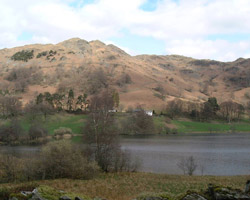|
Elterwater
and Low-wood are two sites in Lakeland that show clear remains of the
once thriving black powder or gunpowder industry. Michael Davies Shiel
is the recognized authority on the subject. The growing demand for the
powder came from quarrying and mining across the North. Saltpetre and
sulphur were imported as vital ingredients. The other requirement was
charcoal, something obtainable from the coppicing of the areas woodland.
Water power was equally important with the earliest works being on the
River Kent, south of Kendal.
The Elterwater works on the River Brathay, now a holiday complex, (Langdale
Estates)are still traceable on the ground. The areas last gunpowder mills
closed in 1937. Saltpetre came from Chile and barrels used to arrive at
Windermere railway station for onward transport. Sulphur came from volcanic
regions such as Stroboli on Sicily. Coppice wood was fed into the greedy
retort furnaces to produce quality charcoal at Gatebeck. Careful grinding
and mixing are the requirements for black powder manufacture. Thus a series
of small water driven grinders and mixers would be spread along a watercourse
such as the Brathay. The risks of explosions in the process means that
work was spread between blast banks in an attempt to limit the potential
for disaster. Any furnaces for drying also had long covered flues to carry
away the sparks well away from the gunpowder areas. Rotary churns and
heavy iron or stone runners were all designed to crush and mix the ingredients.
But always they had to be designed to prevent that stray spark that could
end with an explosion.
In the latter stages of the industry large waterwheels were replaced by
the turbines that became the hallmark of Kendal firm Gilbert Gilkes and
Gordon. Elterwater boasted six water wheels. The friction generated in
some of the earlier grinding processes led to fatal explosions. The crude
black powder was then compressed under great pressure into sheets before
the dangerous process of corning into identical sized pieces for even
explosion. Early corning was done by mallet Equally hair raising was the
later stage of drying the mixture before careful packaging. The site at
Sedgewick is completely overgrown today. Black powder from these Lakeland
works was used around the world, but also nearer home for the iron ore
mining of West Cumbria and Furness.
|
|

